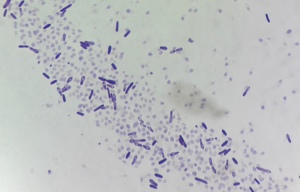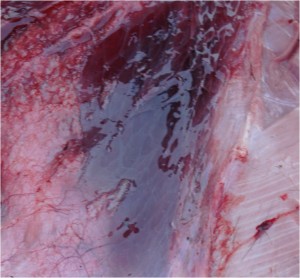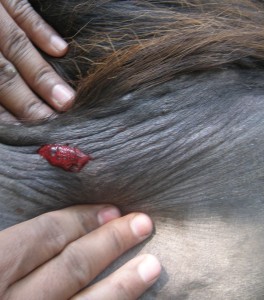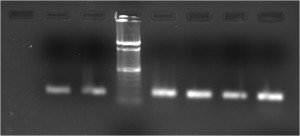Clostridium chauvoei
The name Clostridium chauvoei was given in honor of French veterinarian Auguste Chauveau .
Significant contributions were made to the literature concering blackleg by Arloing, Cornevin and Thomas in 1887, which accounts for the fact that they are often given the credit for discovery of the organism. Even though they did contribute a great deal to the knowledge of blackleg, its cause and immunity, Roux is given the credit for being the first to cultivate the organism on artificial media in 1887.
Clostridium chauvoei is widespread in soils, but it is more prevalent in certain geographic areas. Clostridium chauvoei (also called as Clostridium chauvoei type B, Clostridium feseri) cause ‘Black quarter or Black leg’ in cattle and sheep.It is found in the intestine and in normal tissue of some animals, including the livers of some apparently normal dogs & cattle. It is not as common in the soil as are some other Clostridia.
In India the disease is widespread amongst cattle particularly in South India but sporadic cases occur all over the country and cause heavy losses.
Morphology
 |
Clostridium chauvoei-Gram Positive rods |
Gram positive rods with rounded ends, sometimes pleomorphic, large cigar shaped rods or citron forms occur measuring 0.6u x 3-8u in size.
Occurs singly or in chains but long filaments are also common. Swollen cells are often found, navicular and lemon shapes are very common.
Motile and Non-capsulated.
Spores elongated and arranged subterminally or terminally giving ‘Pear Shaped ’ appearance.
The organism is Gram-positive in tissues and fresh cultures but decolourizes in old cultures. Some cells shows granular material in one or both poles when stained with methylene blue.
Clostridium chauvoei are strict anaerobes.
Growth Requirements
Another method by which growth of anaerobic bacteria is carried out in laboratory.i.e. Anaerobic jars(McIntosh Fildes’ anaerobic jar).In this procedure Gas pack system is used to create anaerobic environment. The gas pack contain- sodium bicarbonate, sodium borohydride, sodium citrate and tartaric acid & Catalyst palladium/Asbestos.
The resazurin act as indicator, it convert purple to pink colour .
Optimum temperature for growth is 37 degree Celsius and growth is best in alkaline media, although the growth takes place in wide pH range.
Growth on ordinary media is poor but can be improved by addition of reducing agents i.e., 0.5% glucose or 1% ascorbic acid or 0.1% Cysteine or 0.1% sodium thioglycollate or heart meat infusion or liver extract helps in maintaining the anaerobic condition.
Cultural Characteristics
On blood agar, whitish grey irregular colonies of 2-4 mm in diameter develop with a zone of haemolysis. The effuse ,transparent colony, finely granular in the center becoming almost invisible towards the periphery-edges resembles ‘Wisps of Hairs’
Bluish gray in transmitted light.
Broth – Clostridium chauvoei produces uniform turbidity in broth, produces gas and form white flaky deposits. In glucose gelatin shake, colonies appear towards the bottom with a gas bubble and surrounded by a liquefied area.
Reinforced Clostridial medium(RCM)
A very useful medium is Reinforced Clostridial Medium. It contains unsaturated fatty acids which takes up oxygen , the reaction being catalysed by hematin in the meat, and also sulphydril compounds which bring about a reduced OR potential. Clostridia grow in the medium, rendering the broth turbid. Most species produce gas. Clostridium chauvoei, saccharolytic species turns the meat pink and produces foul and pervasive odours.
In litmus milk medium , the production of acids, clot and gas can be detected.
Biochemical Properties
Sugars fermented/not fermented by Clostridium chauvoei
| Sugars | Glucose | Fructose | Maltose | Lactose | Sucrose |
Mannitol Glycerol
|
Dulcitol Salicin
|
Inulin |
| Clostridium chauvoei | + | + | + | + | + | – | – | – |
Biochemical tests
Indole,MR,VP, NH3, Methylene Blue, Catalase Test: Negative
Antigenic Structure
All the strains of the organism have one common somatic cell wall antigen but on the basis of flagellar antigen the organism have been divided into two groups. It shares a common spore antigen with Clostridium septicum. The organism when grown in glucose broth containing calcium carbonate produces toxin, which is present in the supernatant fluid. The other toxins are deoxyribonuclease (beta toxin), hylauronidase (gamma toxin) and oxygen-lable haemolysin (delta toxin). The toxin when injected intravenously into a mouse cause respiratory symptoms and death within a few minutes. The Guinea pig is most susceptible and is commonly used as the experimental animal for the organism.
Clostridium chauvoei Alpha toxin (CctA)
Clostridium chauvoei Alpha-toxin has a molecular mass of 27 kDa, but is formed as part of a larger 53.5 kDa complex, which is referred to as the “soluble immunizing component’’ Clostridium chauvoei does not produce titers of alpha-toxin as high as Clostridium septicum, and with cultures of the former it is sometimes difficult to detect. CctA is the main protective antigen in vaccines against blackleg.
Pathogenicity
The Clostridial organisms are commensal intestinal-dwelling bacteria which localise in wounds, bruises or in muscle after heavy exercise, and release toxins and neuraminidase which cause extensive myonecrosis. Clostridium chauvoei causes blackleg or black quarter, an emphysematous, necrotizing myositis in well built, muscular cattle breeds more predominantly. Nowadays reported even in cattle, buffaloes and even in calves. Black Leg/Black Quarter is generally reported in cattle aging 4 months to 3 years.
 |
Emphysematous necrotizing myositis-Blackquarter |
The CctA toxin and neuraminidase plays an important role in development of myonecrosis and emphysema.
A novel protein toxin, named Clostridium chauvoei toxin Alpha (CctA) that belongs to the family of β-barrel pore forming toxins of the leucocidin superfamily of bacterial toxins was discovered by whole genome sequence analysis. The corresponding gene cctA was found in all strains of C. chauvoei analyzed, isolated from various geographical areas over the globe during the last 50 years. CctA is the main cytotoxic and oxygen-stable haemolysin (cattle, sheep and pig red cells) secreted by Clostridium chauvoei. CctA is the major virulence factor of C. chauvoei. It is also a neurotoxin and causes dermonecrosis and fibrinolysis.
The Ccta alpha toxin is a phospholipase C. It degrades lecithin, a major component of cell, and thus destroys red blood cells, platelets and muscle cells, causing myonecrosis. Thus, the release of toxins locally leads to severe necrotizing myositis (MYONECROSIS), and systemic spread of toxins through the bloodstream (systemic toxaemia) results in death.
Neuraminidase (Sialidase) belong to a class of glycosyl hydrolases that release terminal N-acetylneuraminic (silaic acid) residues from glycol proteins, glycoloipids and polysachharides. Neuraminiadse is a key enzyme in sialic acid catabolism, hydrolyzing the glycosidic linkage between sialic acid moleculaes and glycoconjugates. Neuraminiadse play a significant role in the pathogenesis of infectious diseases by cleaving sialic acids in infected tissues to facilitate the spread of disease.
Clinical findings:
Black Quarter(B.Q.) is characterized by swelling , edema and emphysema of the muscles and subcutaneous tissues of infected part. The infection occurs mostly in the shoulder and hindquarter. Swelling increases rapidly in size and emphysema is soon detected by the ‘Crackling sound’ when the hand is drawn firmly across the affected part. The organisms, along with other anaerobe continue to grow after death, and the body becomes distended with gas. The subcutaneous tissue of infected part is edematous, gelatinous and are permeated with blood and gas bubbles. The underlying muscles are dark brown or even blackish, hence the name black leg. A very characteristic sweetish, sour, pungent odour can be detected from the infected tissue.
In cattle disease results fatally in 1-3 days after the onset of first symptoms.
Immunity:
Animals recovered from an attack of blackquarter are immune for long life. Very young and aged cattle have considerable degree of natural immunity. Active immunization is practiced extensively.
Diagnosis
1. Isolation & Identification of Clostridium chauvoei
Material collection: Muscle piece from affected part i.e., emphysematous area or discharge from affected muscle after taking incision.
 |
Emphysematous discharge from affected muscle-Blackquarter |
The diagnosis is laborious & not usually carried out. Not always significant. But the organism is usually found in smears made directly from the infected muscle. Practically bacteria can be seen in hardly 5% cases in direct smears. If emphysematous discharge is collected from affected part and inoculated in Reinforced Cooked Meat Medium (RCM) and incubated at 37 degree Celsius for 12-24 hours, being saccharolytic in nature Clostridium chauvoei turns meat freckles in RCM to pinkish in colour. Smear prepared from such growth in RCM gives positive picture of Clostridium in the suspected material.
2. Polymerase chain reaction can be applied to the DNA extracted directly from the emphysematous fluid from the affected part in Black quarter and is helpful in diagnosis of Clostridium chauvoei.
| 1 2 M 3 4 5 6 |
 |
| PCR amplification of CCta gene L. M 100bp ladder, Amplified PCR product (206 bp) using DNA extracted directly from clinical material (Cch1,Cch2) and PCR product of DNA extracted from field isolates(Cch5,Cch6,Cch7 & Cch8) |
3. Animal Inoculation test: Intramuscular inoculation of suspension of infected tissue into Guinea pig produces characteristic lesion and organisms can be isolated in pure culture.Guinea pig dies within 48 hours after injecting the suspected material.
4. Fluorescent Antibody Technique (FAT) can be applied for identification of organisms in tissues.
Treatment & Control
Aged and very young animals have considerable immunity. Active immunization is carried out by alum precipitated whole culture vaccine which is formalized. It is advantageous to employ a multicomponent vaccines containing Clostridium septicum, Clostridium welchii type D and Clostridium tetani besides Clostridium chauvoei cultures. The animals are vaccinated before the onset of rainy season. In sheep the vaccination is done prior to lambing, castration or docking.
BQ vaccine is prepared from good antigenic strain of Clostridium chauvoei & Clostridium septicum in liquid medium grown anaerobically and rendered non-toxic by addition of formalin. The vaccine contains killed cells and toxoids of both species.
Dose of vaccine: 5ml Cattle, 2 ml sheep/goats
Route: S/c
Immunity: 1 Year
Hyper immune serum (HIS) is used to control explosive outbreaks and is of aid in treating as well as producing a passive immunity for a period of about two weeks. It is prepared by hyperimmunization of cattle with any of the above products.
Penicillin along with HIS is used to treat the disease.
Oxytetracycline & Chlortetracycline can also be employed effectively in early stages.
References
N.M.Useh, A.J. Nok and K.A.n. Esievo, Pathogenesis and pathology of blackleg in ruminants: the role of toxins and neuraminidase Am short review Veterinary quarterly 2003, 25(4): 155-159
Frey J, Johansson A, Bürki S, Vilei EM, Redhead K. Cytotoxin CctA, a major virulence factor of Clostridium chauvoei conferring protective immunity against myonecrosis. Vaccine. 2012 Aug 10;30(37):5500-5.
Textbook of microbiology-Ananthanarayan and Panniker’s
Essentials of veterinary bacteriology and mycology- G.R. Carter and Darla J. Wise.
Veterinary bacteriology and virology-Merchant and Packer.
A textbook of veterinary special pathology-J.L. Vegad.
